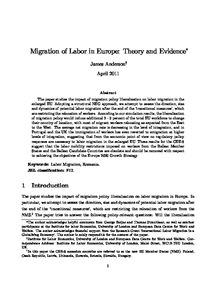Migration of labor in Europe: theory and evidence

Institute for Economic Forecasting, Bucarest ; Anderson, James
IPE - Bucarest
2011
26 p.
EU policy ; labour mobility ; migrant worker ; migration policy
Labour market
English
Bibliogr.
"The paper studies the impact of migration policy liberalization in the enlarged EU. Adopting a structural NEG approach, we attempt to asses the direction, size and dynamics of potential labor migration after the end of the 'transitional measures', which are restricting the relocation of workers. According to our simulation results, the liberalization of migration policy would induce additional 2 -3 percent of the total EU workforce to change their country of location,with most of migrant workers relocating as expected from East to the West. The average net migration rate is decreasing in the level of integration, and in portugal and the UK the immigration of workers has even reverted to emigration at higher levels of integration, suggesting that from the economic point of view no regulatory policy responses are necessary to labor mobility restrictions inposed on workers from the balkan member States and the Balkan Candidate Countries are obsolete and should be removed with respect to achieving the objectives of the Europe 2020 Growth Strategy. "
Digital
The ETUI is co-funded by the European Union. Views and opinions expressed are however those of the author(s) only and do not necessarily reflect those of the European Union or the ETUI.